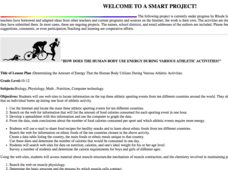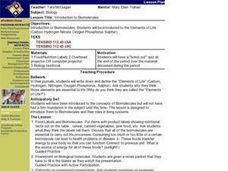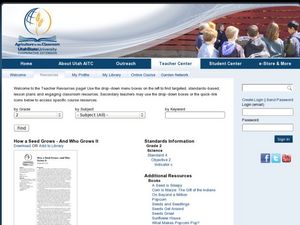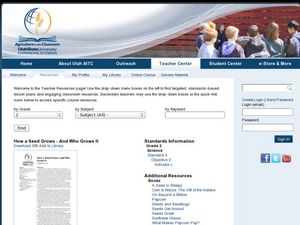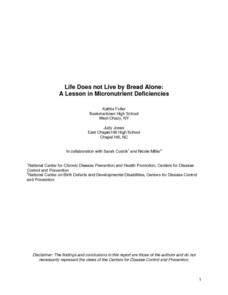University of Rhode Island
How Does the Human Body Use Energy during Various Athletic Activities?
Students investigate how much energy is used during different athletic activities. They conduct Internet research to obtain information on the top three athletic sporting events from around the world, and calculate the calories burned...
Curated OER
Introduction to Biomolecules
Young scholars are introduced to biomolecules and their roles in livin systems. They are introduced to the "Elements of Life." Students write down and define the "Elements of Life." They are asked why they think those elements are...
Curated OER
Ecology and the Conservation of Natural Resources Lesson 2
Learners compare and contrast abiotic and biotic factors. They discuss how these factors effect ecosystems. They answer questions to complete the lesson.
Curated OER
Algae Experiments
Students describe the characteristics of algae. In this biology lesson, students perform a series of experiment to explore algae. They investigate the basic things algae need to survive.
Curated OER
Chemical Leavening Agents
Young scholars examine chemical leavening agents in dough and batters.
Curated OER
Our Healthy Bodies
Students complete a variety of activities designed to enhance their awareness of their bodies. They examine pictures of themselves, taken at various points in the year and examine and compare their bodies. They enjoy a healthy snack...
Curated OER
Abbreviations, Substitutions, Equivalents Review Lab
Students work together to prepare a cookie recipe. In groups, they measure ingredients and review abbreviations and substitutions when it comes to different systems of measurement. To end the lesson, they demonstrate the use of the...
Curated OER
How Does Climate Affect Plant Growth?
First graders compare plant samples obtained from two different sites to explore how climate affects plants.
Curated OER
Dietary Guidelines 2000
Students research dietary guidelines and create a Microsoft Powerpoint presentation that reviews the dietary guidelines to present to their class or an elementary class.
Curated OER
Health In Progress/ Soft Drinks
Students engage in a lesson that is concerned with the consumption of soft drinks by children. They examine the statistics about the consumption and determine the increase or decrease in individual servings consumed over time. They...
Curated OER
How a Seed Grows and Who Grows It
First graders explore biology by viewing PowerPoint presentations in class. In this plant life lesson, 1st graders identify the life cycle of a plant and how to properly plant a seed outside. Students view a movie about plant life and...
Curated OER
Citizens For the New Zoo
Third graders complete Internet research to find information about an animal and its basic needs. They design a model of a zoo habitat that would accommodate their animal. They write a letter of recommendation to a Zoo board of directors...
Curated OER
How a Seed Grows: And Who Grows It
Second graders explore botany by viewing video clips in class. In this seed growth lesson plan, 2nd graders identify the types of seeds that grow specific plants and what the optimal conditions are for growing seeds. Students view a...
Curated OER
Life Does Not Live By Bread Alone
Young scholars investigate the relationship between micronutrients and proper metabolic function. The lesson should serve as an introduction to the subject. The subject of the function includes the study of plants, animals, and humans....
Curated OER
What Do Dog's Need?
Learners discuss proper care of pets. In this animal care lesson, students discuss what pets need to be healthy and happy. Learners act out roles of pets and owners and create a pet tag.
Curated OER
Next Year's Seeds
Fifth graders explore genetic traits. In this genetic traits lesson, 5th graders discover how traits are passed from parent to offspring while examining plants. Students problem solve real world applications.
Curated OER
Breads Around the World
Sixth graders explore world cultures by researching dietary habits. In this bread identification lesson, 6th graders explore different regions around the world and the types of breads they produce. Students read assigned text about the...
Curated OER
Ocean Market
Students identify some consumer goods that come from the ocean.
They classify these items into groups, identify their source, and calculate the cost of buying such goods.
Curated OER
Hydroponics
Students discuss the concept of hydroponics. They create and run their own hydroponics system. They record and analyze the data they collect.
Curated OER
Heat Transfer
The students construct a heating curve and explain its components. They perform calculations. They review phase changes and quantify Energy differences. They review phases of matter and their energy content.
Curated OER
Recombinant DNA to Protect Crops
Students read an article about manipulation of plant DNA. After reading the short article, they work in small groups to respond to the provided discussion questions and explain their answer to the class.
Curated OER
Diet, Exercise and AIDS
Pupils research AIDS and the role of diet and exercise with the disease. In this AIDS instructional activity, students listen to a mini lecture about the diet and exercise needs of people who have AIDS. Pupils learn about alternative...
Curated OER
Why is rice important?
Second graders examine why rice is so important to the world. In this agriculture lesson, 2nd graders discover the origins of rice farming. Students study how many countries depend on rice for survival. Students research countries and...
Curated OER
Developing Civilizations and the Role of Rice
Student investigate how civilizations developed. In this rice farming instructional activity, 5th graders explore how rice cultivation changed through different civilizations. Students gain knowledge about different types of rice, where...


